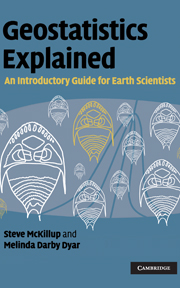Book contents
- Frontmatter
- Contents
- Preface
- 1 Introduction
- 2 “Doing science”: hypotheses, experiments and disproof
- 3 Collecting and displaying data
- 4 Introductory concepts of experimental design
- 5 Doing science responsibly and ethically
- 6 Probability helps you make a decision about your results
- 7 Working from samples: data, populations and statistics
- 8 Normal distributions: tests for comparing the means of one and two samples
- 9 Type 1 and Type 2 error, power and sample size
- 10 Single-factor analysis of variance
- 11 Multiple comparisons after ANOVA
- 12 Two-factor analysis of variance
- 13 Important assumptions of analysis of variance, transformations and a test for equality of variances
- 14 Two-factor analysis of variance without replication, and nested analysis of variance
- 15 Relationships between variables: linear correlation and linear regression
- 16 Linear regression
- 17 Non-parametric statistics
- 18 Non-parametric tests for nominal scale data
- 19 Non-parametric tests for ratio, interval or ordinal scale data
- 20 Introductory concepts of multivariate analysis
- 21 Introductory concepts of sequence analysis
- 22 Introductory concepts of spatial analysis
- 23 Choosing a test
- Appendices
- References
- Index
21 - Introductory concepts of sequence analysis
Published online by Cambridge University Press: 05 June 2012
- Frontmatter
- Contents
- Preface
- 1 Introduction
- 2 “Doing science”: hypotheses, experiments and disproof
- 3 Collecting and displaying data
- 4 Introductory concepts of experimental design
- 5 Doing science responsibly and ethically
- 6 Probability helps you make a decision about your results
- 7 Working from samples: data, populations and statistics
- 8 Normal distributions: tests for comparing the means of one and two samples
- 9 Type 1 and Type 2 error, power and sample size
- 10 Single-factor analysis of variance
- 11 Multiple comparisons after ANOVA
- 12 Two-factor analysis of variance
- 13 Important assumptions of analysis of variance, transformations and a test for equality of variances
- 14 Two-factor analysis of variance without replication, and nested analysis of variance
- 15 Relationships between variables: linear correlation and linear regression
- 16 Linear regression
- 17 Non-parametric statistics
- 18 Non-parametric tests for nominal scale data
- 19 Non-parametric tests for ratio, interval or ordinal scale data
- 20 Introductory concepts of multivariate analysis
- 21 Introductory concepts of sequence analysis
- 22 Introductory concepts of spatial analysis
- 23 Choosing a test
- Appendices
- References
- Index
Summary
Introduction
Geoscientists often have to interpret data that are in the form of a sequence – an ordered series of observations – that has been measured over time or space. For example, on a temporal scale you might have data for sea level that has been repeatedly sampled at the same location over several months, years, or decades and need to know if the mean has changed, whether there is a consistent trend, or even repetition of the same pattern. The analysis of temporal scale data is often called time series analysis. On a spatial scale, sequential data might be obtained as a core from a bore hole drilled down through a sedimentary sequence or a stack of lava flows. Although such sequences are spatial, they could also be thought of as temporal because deeper rocks are likely to be older, but depth and age are unlikely to be equivalent because the thickness deposited may vary among years. Nevertheless, the same statistical methods can often be used for both temporal and spatial sequences.
Data for a sequence can be measured on a ratio, interval scale or ordinal scale (e.g. the conductivity of well water over several months) or a nominal scale (e.g. chemical or porosity changes with depth in a stratigraphic sequence).
Analysis of a sequence might detect a trend (or a lack of it), or reveal features that may lead to hypotheses about temporal or spatial processes.
- Type
- Chapter
- Information
- Geostatistics ExplainedAn Introductory Guide for Earth Scientists, pp. 297 - 333Publisher: Cambridge University PressPrint publication year: 2010

